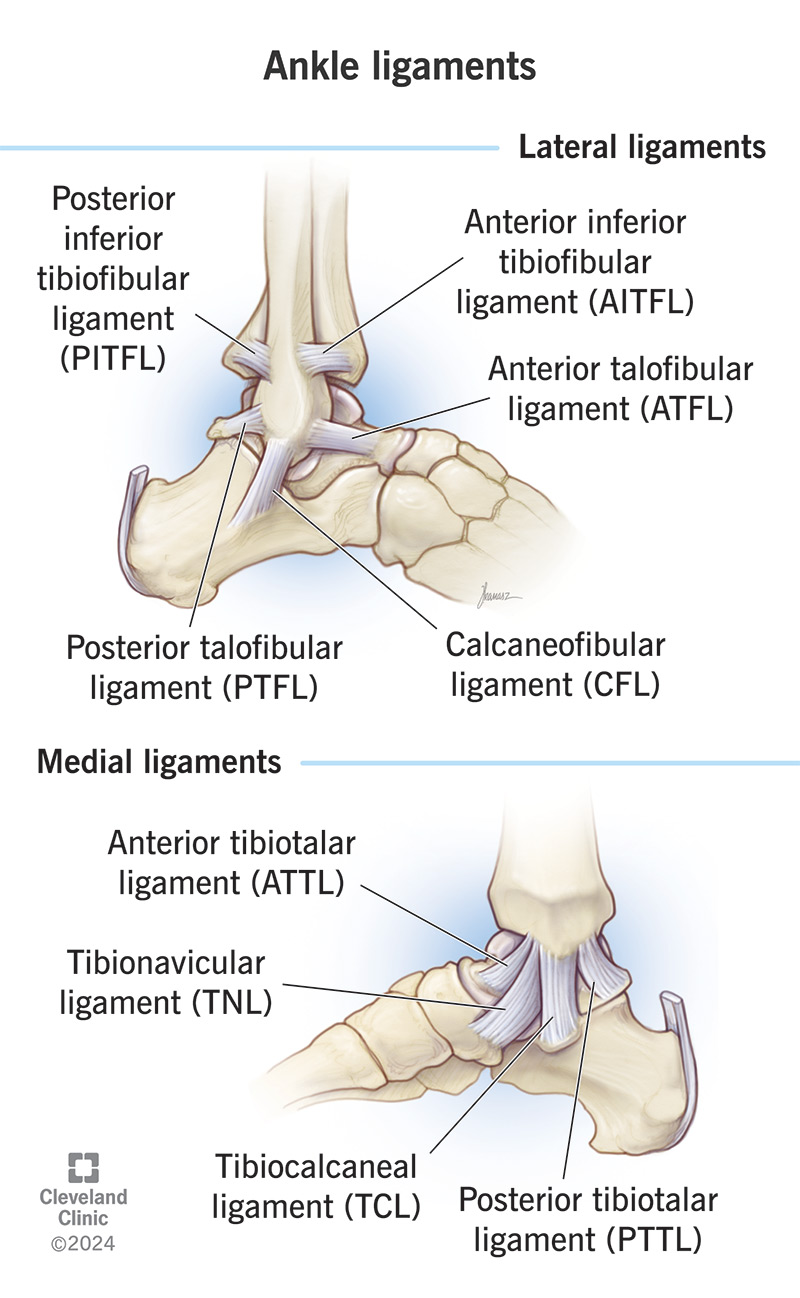Ankle ligaments are strong but stretchy pieces of connective tissue that connect your foot bones with your lower leg bones. They stabilize your ankle joint and prevent your ankle from twisting, folding or collapsing. Ankle ligaments can overstretch or tear, called a sprain. Ankle sprain is a very common injury that can range from mild to severe.
Advertisement
Cleveland Clinic is a non-profit academic medical center. Advertising on our site helps support our mission. We do not endorse non-Cleveland Clinic products or services. Policy

Your ankle ligaments are firm bands of fibrous tissue that connect your foot bones (talus and calcaneus) with your lower leg bones (tibia and fibula). The ligaments of the ankle help keep your bones in the proper position and help stabilize your ankle joint. They also prevent your ankle from twisting or collapsing.
Advertisement
Cleveland Clinic is a non-profit academic medical center. Advertising on our site helps support our mission. We do not endorse non-Cleveland Clinic products or services. Policy
Without ankle ligaments, you wouldn’t be able to stand, walk or run. Located on both sides of your ankle, they help absorb the shock of any movements you make. If you develop any pain in your ankle ligaments, it’s important to see a healthcare provider for prompt diagnosis and treatment.
There are three main sets of ligaments in your ankle. They all surround and support the different parts of your ankle to keep your body moving properly.
Also known as the deltoid ligaments, these are located at the inner side of your ankle. They start at the medial malleolus (the end of the tibia), which forms the bump on the inside of your ankle. Then, they fan out to connect to your talus, calcaneus and navicular bones. The four main medial ligaments are:
The lateral ligaments are located at the outer side of your ankle. They start at the lateral malleolus (the end of the fibula), which forms the bump on the outside of the ankle. Then, they connect to your talus and calcaneus bones. The three main lateral ligaments are:
Advertisement
The syndesmotic ligaments connect your tibia and fibula bones. The five main syndesmotic ligaments are:
While you probably don’t think about them much, your ankle ligaments have several important jobs. They:
Ankle ligaments are made of strong, cord-like connective tissue that contains:
You have ankle ligaments throughout your foot, ankle and lower leg. They connect certain bones:
You can injure an ankle ligament when it moves in the wrong direction, stretches too far or tears. A ligament injury is called a sprain.
A sprained ankle is a very common injury. It happens to people of all ages and levels of health. An ankle sprain usually occurs when someone twists their ankle. For example:
If you think you have a sprained ankle, a healthcare provider may:
You can’t prevent all ankle injuries, but you can take steps to keep your ankle ligaments safer, especially during physical activity. Steps you can take include:
Advertisement
While you probably don’t think about them very much, the ligaments in your ankles have many important jobs. So, it’s important to take care of them. Make sure you’re stretching before and after participating in any sort of physical activity. And make sure you’re always wearing supportive shoes. If you experience any pain in your ankle ligaments, reach out to your healthcare provider. They can help assess what’s going on and determine the treatment you need to get you back on your feet.
Advertisement
Cleveland Clinic offers treatment for ankle arthritis, bursitis, sprained ankles and other causes of ankle pain — often without surgery.

Last reviewed on 12/02/2024.
Learn more about the Health Library and our editorial process.